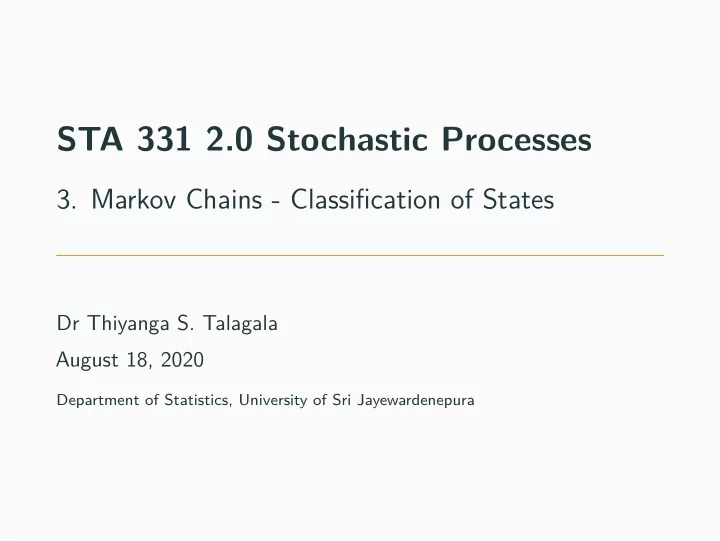

STA 331 2.0 Stochastic Processes 3. Markov Chains - Classifjcation of States Dr Thiyanga S. Talagala August 18, 2020 Department of Statistics, University of Sri Jayewardenepura
Example 1 1 0 Find the equivalence classes. 1 4 1 4 4 1 1 4 0 0 0 1 2 0 2 2 P = 1 1 2 1 0 2 0
Theorem The relation of communication partitions the state space into mutually exclusive and exhaustive classes. (The states in a given class communicate with each other. But states in difgerent classes do not communicate with each other.) 3
Defjnition process will ever re-enters state i , i.e, 4 Let f i denote the probability that, starting in state i , the f i = P ( X n = i for some n ≥ 1 | X 0 = i )
Example 2 1 0 Consider the Markov chain consisting of the states 0, 1, 2, 3 1 4 1 4 4 1 1 4 0 0 0 1 Find f 0 , f 1 , f 2 , f 3 . 2 0 2 1 with the transition probability matrix, P = 1 5 2 2 0 1 0
Recurrent and transient states 6 Let f i be the probability that, starting in state i , the process will ever re-enter state i . State i is said to be recurrent if f i = 1 and transient if f i < 1.
Example 3 1 Determine which states are transient and which are recurrent. 0 2 1 2 1 2 1 0 Consider the Markov chain consisting of the states 0,1,2 with 2 2 1 2 1 0 P = the transition probability matrix 7
Example 4 0 Determine which states are transient and which are recurrent. 0 1 0 0 0 0 2 1 2 Consider the Markov chain consisting of the states 0, 1, 2, 3 1 0 1 0 1 with the transition probability matrix P = 8 0 0 0
Example 5 1 1 2 Consider the Markov chain consisting of the states 0, 1, 2, 3, 4 1 2 0 0 0 0 0 2 0 1 2 0 0 0 1 2 1 2 Determine which states are transient and which are recurrent. 0 0 4 1 with the transition probability matrix P = 1 1 2 0 9 2 4 0 1 2 1 0
Theorem if state i is recurrent then, starting in state i , the process will re-enter state i again and again and again—in fact, infjnitely often. 10
Theorem state i , the process will ever re-enter state i . If state i is transient then, starting in state i , the number of time periods that the process will be in state i has a geometric distribution with fjnite mean 1 Proof: In-class 11 For any state i , let f i denote the probability that, starting in 1 − f i .
12
Theorem State i is recurrent if P n transient if P n Proof: In-class 13 ∞ ∑ ii = ∞ , n = 1 ∞ ∑ ii < ∞ , n = 1
Corollary 1 If state i is recurrent, and state i communicates with state j Proof: In-class 14 ( i ↔ j ), then state j is recurrent.
Corollary 2 In a Markov Chain with a fjnite number of states not all of the states can be transient (There should be at least one recurrent state). Proof: In-class 15
Corollary 3 If one state in an equivalent class is transient, then all other states in that class are also transient. Proof: In-class 16
Corollary 4 Not all states in a fjnite Markov chain can be transient. This leads to the conclusion that all states of a fjnite irreducible Markov chain are recurrent . Proof: In-class 17
Acknowledgement The contents in the slides are mainly based on Introduction to Probability Models by Sheldon M. Ross. 18
Recommend
More recommend